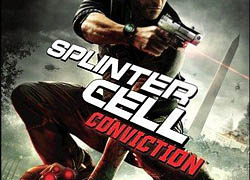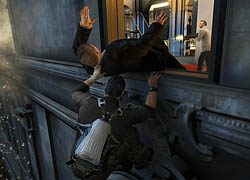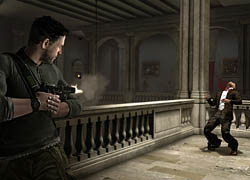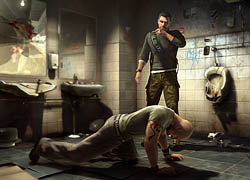Here is a video log of my experiences over the three days up in Boston for the highly anticipated, 1st annual, PAX East video game convention.
-Ray Carsillo
Sunday, April 25, 2010
RAY INVADES PAX EAST 2010
Labels:
APB,
bad company,
battlefield,
boston,
combat,
crackdown,
east,
FPS,
frobot,
graphics,
making history,
massachusetts,
monday night,
nvidia,
PAX,
RTS,
video games,
Xbox 360
Friday, April 16, 2010
WAVERING CONVICTION

Sam Fisher is back in Splinter Cell: Conviction and not only have the rules of the espionage game changed, but so has the game that players have come to know and love.
SPOILER ALERT: If you have not played the previous Splinter Cell games, be warned that there may be references to previous events of the Splinter Cell series.
Splinter Cell: Conviction opens up with Sam Fisher sipping a drink in Malta, a small island nation in the Mediterranean, as he tries to piece back together his life after the death of his daughter in a drunk driving accident three years earlier. Having left Third Echelon after his last mission pushed him past a point he didn’t think he could return from, where he killed one of his best friends in Irving Lambert, Sam appears completely lost. That is until an angel watching over him appears to deliver him from the brink.
Well, not quite an angel. More like his old handler Anna “Grim” Grimsdottir watching him via a low orbiting satellite. Grim contacts Sam and explains that his daughter’s death wasn’t an accident and that the people who set that up and used his grief to take him out of the espionage game are now targeting the US’s first female president.

Driven by rage and a quest for vengeance, Sam Fisher has never been more dangerous as he only works for himself now. Saving the president will only be a bonus for nothing will get in the way of the revenge Sam will try to enact on to the people who took his daughter away from him.
A nice twist on the classic Splinter Cell plot, where Sam always has to save the world from terrorists, this new game fleshes out the character of our favorite agent with flashback levels and constant plot surprises that I will not spoil here.
The first thing you will notice is that this is easily one of the best looking games out there right now. From blood splattering accurately on walls from headshots to the detail of the characters’ faces, Splinter Cell: Conviction is a gorgeous game. It’s a shame that half of it is spent, literally, in the dark.
A new color-changing system implemented in the scenery informs you of when you are hidden from enemy sight. When hidden, the world is black and white. When you’re in the open, the world is full of vibrant colors. Although a nice idea to help the player try to progress through the levels and around patrols, it takes away from the visuals and makes it difficult to make out cover most of the time. I would have preferred if they had simply left this system out and left it to the player to figure out if they were in the open. Usually the gunfire is a dead giveaway.

The audio for the game though is spectacular. Michael Ironside reprises his role as Sam Fisher and heads up a strong voice over cast that all end up giving great performances. The music helps set the tone of the gameplay and knows exactly when to amp things up and tone things down. Topped off with spot-on SFX and Splinter Cell: Conviction is something that other game developers should listen to when focusing on the audio of their games.
The biggest change from previous Splinter Cell installments though comes from the gameplay. Although there is still a very strong emphasis on stealth, with Sam not being weighed down by his Splinter Cell suit he moves much quicker than he has in previous games.
Along with this emphasis on speed, there is a new “mark and execute” system where Sam can earn some one shot assassination style kills whenever he takes out an enemy in hand-to-hand combat, throws him from a window, or drops on him old-school Splinter Cell style from an overhead pipe.
Once marks are earned, if Sam can see his foe, either from line of sight, underneath the door with his snake camera, or through walls with his new sonar goggles (more on that in a sec) he can mark up to four guys at once depending on what gun he is using (shotguns usually only give you two marks, while Sam’s favorite Five-Seven pistol can get the aforementioned four marks) and when he is in range, the marks turn red. Then with one press of the Y button, Sam turns his would be attackers into instant doormats as some awesome bullet-time sequences play out as Sam executes his marks with one shot each. This mode is a great, quick way to help even the odds in a heavily populated room or to clear one out before the terrorists even know what hit them.

Another nice addition is the new “interrogation” system. Although you’re really just mashing the B button, watching Sam smash the faces of targets of interest against urinals, TV screens, and with the butt of his gun is a beautiful new technique to advance the story. Next time, Ubisoft just might want to make these full-blown button prompt sequences though to add some difficulty to this.
Unfortunately, one minor complaint about the gameplay is the new “sonar goggles”. No longer being a part of Third Echelon has forced Sam to forfeit his signature night vision goggles and about half way through the story mode, Sam acquires these cheap knockoffs instead.
The sonar goggles work just like regular sonar, sending out bleeps in Sam’s general vicinity that can map out the area around him. It’s a good way to see enemies through walls, but it takes away from so much of the terrain that it feels like you’re playing some ancient shooter like the original Wolfenstein or the first Doom (classics for what they were, not something I need to play right now).
Speaking of enemies, the A.I. is hit or miss. I played through the single player campaign mode on the hardest difficult and still only sometimes do the enemies act brilliantly as they try to outflank Sam or create distractions for you. Just as often, instead of just reacting, they exclaim, “We’ve got to try to spread out!” Thank you for telling me your plan of attack so that I can react accordingly and pick you off one by one. Or when taking on opposing Splinter Cells who also have sonar, but act like regular thugs when trying to traverse through smoke screens.
The worst part about the gameplay though is how short the single player and co-op campaigns are. It only took me eight to nine hours to beat all 11 single player missions and another two or three to go through the four co-op prequel missions. Fifteen missions in ten hours is too short to drop a full $60 on.
The replay value suffers as well with the versus modes of old having been scrapped in favor of more co-op vs. CPU matches in new game modes like “Hunter” and “Last Stand” where you get to play as either an American Third Echelon agent or Russian Voron (Russian equivalent of Third Echelon) agent. In these modes you’re pit against the CPU terrorists and complete sweeps of locations from the campaign modes or defend certain locations. Although fun, taking away the more traditional vs. modes from previous installments of the series was disappointing.
Overall, Splinter Cell: Conviction is a nice experiment with the series with new gameplay elements and with an open-ending for a sixth console release if they so chose, but I would hope that Ubisoft got their artistic juices out with this one and will go back to focusing on having Sam Fisher do what he does best and not worrying about playing around with color schemes and fancy gadgets.
Ratings are based on a scale of 1 to 10 with 10 being the best.
Graphics: 8.0: If it wasn’t for the crazy changing color and sonar schemes that you’re constantly having to deal with, this would be a perfect score because when the screen is actually in full color, it looks fantastic in terms of blood splatter effects and the details of many facial features, some of the hardest things to digitize.
Audio: 10.0: A tremendous voice cast led by Michael Ironside helps to paint the emotion conveyed throughout this latest chapter in the Splinter Cell series. Add in the usual fantastic orchestrations and perfect SFX and I can’t give the audio anything less than a perfect score.
Plot/Plot Development: 8.0: An original and inventive way to mix up the usual story of Sam trying to save the world from terrorists, but I felt it also took the game away from its roots enough to put off the series’ diehards.
Gameplay: 7.0: It was nice to see Ubisoft trying to mix things up to try to keep things from getting stale, but when you mess with too much, you lose what made the series great to begin with. I love the “mark and execute” system, but the color-changing scheme to represent when you’re in the dark or not was more of a nuisance than a help and the “interrogation” system was pretty, but offered no challenge. When you add in that the entire single player and co-op campaigns are only worth about ten hours total and you have an average score at best.
Replay Value: 5.0: Unless you’re an achievement hog, you’ll only need to play the story mode once to get everything you need from it. And the lack of a traditional vs. mode in the multiplayer I think takes a lot away from the replay value of this game and puts it in mediocre company in terms of bringing players back for more.
Overall (not an average): 7.0: It was nice to see Ubisoft try a few new things with this latest Splinter Cell, but not all of them worked. Couple that with a lack of replay value and overall length to the campaigns and I would recommend Splinter Cell: Conviction as a nice rental over a rainy weekend, but not as a full-blown $60 purchase.
Splinter Cell: Conviction is available now for the Xbox 360.
-Ray Carsillo
Labels:
conviction,
ray carsillo,
sam fisher,
splinter cell,
video games,
Xbox 360
Subscribe to:
Comments (Atom)